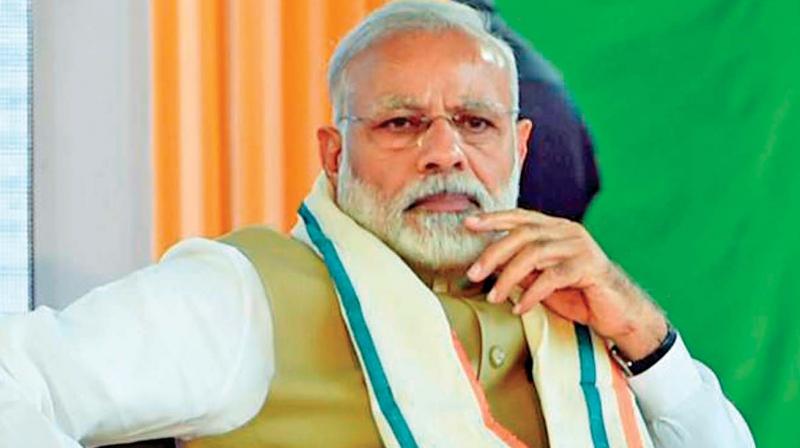Jobless growth rising crisis for Modi Sarkar

Jobless growth, widely applied to the era of high growth from 2004 to 2009, has now become the bane of the Narendra Modi government. Not only is the economy flailing in its ability to deliver on its promises of “Make in India”, Swachchh Bharat, eradicating black money and bringing back the billions stashed abroad, it has also failed to give any succour to those seeking a livelihood. None of its programmes have seriously worked out the economic and job implications. The present government has been unable to generate enough jobs. The problems are partly structural — of being a few decades behind the countries in East Asia and Southeast Asia in catching the export boom. But such a situation has also arisen because of the government’s inability to forge a suitable policy, its indifference to the crisis in people’s lives and its obsession with things like cow slaughter without bothering about its consequences on farmers’ livelihoods. The numbers tell a straightforward story even if they are incomplete. India was able to add only 135,000 jobs in eight labour-intensive sectors surveyed by the Labour Bureau in 2015 (the figure for 2016 has not yet been released), steadily declining from a peak of 930,000 jobs added in 2011. Both figures are much lower than the need to cater to the 10 million people entering the “labour force” every year.
In its appraisal of the 12th Five-Year Plan (2012-17) released recently, the Niti Aayog noted: “Higher focus on investment in capital- and skilled-labour-intensive sectors in the country meant that the movement of workers out of agriculture into industry and services has been specially slow for the past 65 years.” The Modi government has concentrated on capital-intensive and high-skilled sectors. This has meant that the fast-growing sectors in India with job opportunities have been automobile and its parts, two-wheelers, machinery, chemicals, petroleum refining, telecommunications, software and pharmaceuticals. The concentration on capital-intensive sectors has meant that the sectors that are employment intensive, like textiles and garments, leather tanning and processing, diamond polishing and jewellery manufacture, agro-industries like food processing and cold storages have been ignored. A case in point is the labour-intensive clothing industry. The Aayog said: “India has performed rather poorly in this sector. (Clothing) exports from India started at a lower level in 1997 and also grew at a significantly slower pace. By 2013, these exports from China had risen to $177 billion, while those from India amounted to just $17 billion”.
“Unfortunately, more than China’s exceptional performance, this comparison testifies to generally poor performance of Indian exports of labour-intensive products. Today, India’s exports of clothing and accessories in absolute terms fall short of not just Bangladesh but also Vietnam, whose population is 90 million. The story is similar in other labour-intensive items such as leather products, food processing and electronic assembly”, the Aayog said. Two social sectors that are largely ignored by the Niti Aayog are health and education. This is in keeping with the government policy to gradually reduce the money allocated to them. Instead of a mindless rush to fund universities and colleges that pretend they are equal to the world’s best, a balanced approach on school education would raise the level of schools around the country and provide more jobs than industry can. Most village schools have just one teacher, who single-handedly handles Class 1 to Class 8. By having four teachers for each school in India’s seven lakh villages would not only raise the level of education and ability of students to deal with the world, it would also generate useful employment for nearly three million otherwise disgruntled youngsters.
Similarly, by ensuring that the primary health centres are manned by a sufficient number of trained medical helpers would not only give employment but also improve medical care. From 1991, Dr Manmohan Singh had initiated the new economic policies. Though the share of agriculture in national GDP has been steadily going down that of manufacturing has remained unchanged with almost all the gain going to services. Part of the decline in employment in cotton textiles and food products is because of sickness or obsolescence, which accounted for a sizeable part of factory employment. One reason why employment has not gone up as it should have is that when jobs are created almost an equal number are lost. A recent report by the Boston Consulting Group (BCG) states that employment has not kept up with growth because of productivity increases. Between 1999-2000 and 2012-13 only 52 million jobs were created instead of 355 million, because owners invested in machinery to reduce dependence on labour. Labour is mainly concentrated in the small informal sector in which something like 84 per cent of all industrial employment is found. Any government serious about tackling unemployment would turn here for solutions. But for all the brave talk of “Make in India”, the Modi government has ignored this sector totally. “Microenterprises have the potential to propel growth and job creation”, says the BCG report. However, for this to happen, the government must be sensitive to their needs — providing financial help and training.
It has to simplify procedures of dealing with the government. Instead, Mr Modi’s recent moves have made life more complicated — first the demonetisation gambit hurt the capacity to raise working capital. Then the level of paperwork involved in the GST will drown any entrepreneurial spirit in bureaucratic hurdles. The government seems to work for big business or lobbies, with its emphasis on reducing the influence of labour. It has made no attempt to seriously consider employment. The stage is being set for the violent confrontation we have seen in Gujarat, Rajasthan and now Maharashtra.

